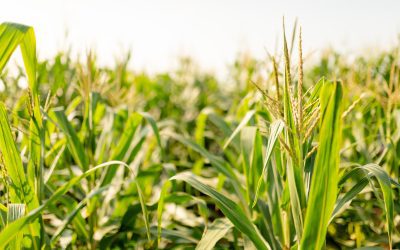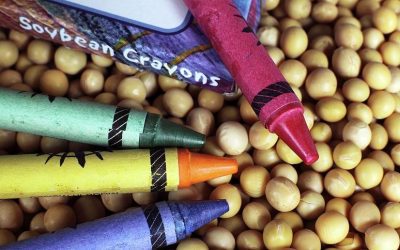BY SUSAN HAYHURST
Anngie Steinbarger has a heart for agriculture. She has testified about crop insurance before the U.S. Senate Agriculture Committee raised her daughters on a working farm, and judged the Purdue Student Soybean Innovation Competition as a member of the Indiana Soybean Alliance board of directors.
Steinbarger is a dedicated “agvocate.” “I have always worked in the ag industry. I love the people, and their commitment to preserving the land,” she explained. “I continue to be amazed that so few people can provide food, fuel and fiber to the U.S. and the world.
She and her husband, Mike, began farming in 1983 with her parents, Harlan and Virginia Burbrink. They initially finished cattle and hogs in addition to raising row crops of corn, soybeans and wheat. Their daughters, Hayley Clark and Michelle Tobias, showed heifers in 4-H.
“Our daughters received their first Angus heifers for Christmas when they were 10 years old. It was so fun to see the heifers all groomed and haltered when we picked them up,” Steinbarger said.
The girls kept their heifers and started a cow/calf operation under Smooth Stone Cattle Company at the family farm in Edinburgh. Now the Steinbargers’ farm with their daughters, their husbands Dan Clark and Matthew Tobias, as well as grandchildren. Most of the finished cattle are sold as freezer beef. “Mike and I are grateful that our family wants to participate in the operation,” said Steinbarger.
Their current operation includes no-till row crops and cattle in addition to growing their own cover crop seed and cleaning it. “We plant cereal rye, cut it very early and wet wrap it,” said Steinbarger. “We feed our cattle with it. We also put in irrigation pivots to benefit our crops. Mike believes our cover crops improve soil health tremendously.”
Her professional history and acumen have been gained in a variety of positions. She has worked in sales of fertilizer and chemicals to dealers throughout Indiana and crop scouted fields for DuPont.
“In summertime I’d scout fields, then adjust crop insurance claims in the fall,” Steinbarger said. “I’ve worked in the crop insurance industry for 30 years. I currently work for ProAg. Both of my daughters and a son-in-law work in the same industry.
Crop insurance career
Steinbarger’s crop insurance job opportunity popped up thanks to the family farm needing to replant acres of corn.
“Many years ago, Mike and I filed a replant claim. We told the adjuster the remaining population and asked if the field qualified for a claim,” she said. “When the adjuster completed a field appraisal, the population was similar to mine. The adjuster recruited me to become an adjuster and was a mentor for many years. I have enjoyed the roles of adjuster, claims supervisor, marketing manager and claims specialist over the years.”
Per a USDA 2020 report, 1.4 percent of the U.S. population were farmers providing food and fiber for the 330 million residents. Per 2018, the top four major crops in the U.S. were corn, soybeans, wheat and cotton. Crop insurance coverage for those crops totaled 208 million acres. Exactly 87 percent of planted acres had crop insurance.
Personally, having crop insurance gives Steinbarger an understanding of the challenges facing fellow farmers.
“The positive side of crop insurance is it’s a risk management tool that helps farmers pay operating expenses if they don’t have crops to sell. It provides a level of security to those of us who operate at the mercy of the weather and markets,” she said. “I dare say I’ve paid in more money in premiums than I’ve collected, but crop insurance allows us to maintain cash flow.”
Many farmers remember the benefit of having crop insurance during the drought of 2012. Steinbarger is grateful their operation had such insurance when their corn produced 40 bushels per acre rather than the usual 180 bushels per acre. “Without crop insurance we would not have been able to pay our bills and plant the 2013 crop.
What advice does Steinbarger have for farmers starting out? “Crop insurance is a risk management tool you can’t afford to ignore because it offers certainty and predictability. There is so much risk for farmers, crop insurance provides banks assurance that farmers can repay borrowed funds,” she said. “This demand for assurance through crop insurance has increased over the years. Banks expect new farmers to buy crop insurance so they can farm year after year. No bank is going to lend you money unless you’re making money. You need money to repay bank loans. Crop insurance provides debt repayment assurance when a farmer experiences unfavorable weather or markets.”
She noted older farmers have similar concerns as younger farmers. “Younger farmers are trying to gather operating money while older farmers are trying to protect their operating money. Seasoned farmers feel the effects of rough years and don’t have many years to rebuild lost operating money,” she said. “Crop insurance helps farmers mitigate risk. Other farm programs are valuable, too. Crop insurance shouldn’t be the only tool you use to mitigate risk.”
The farm bill conversation
As the new farm bill conversation continues, many insured farmers are concerned the crop insurance program may change. Steinbarger’s big concern is the possible separation of the nutrition title from the bill. “The nutrition title comprises 80 percent of the farm bill. I am concerned that decoupling the nutrition title from the bill would prevent passage.”
“We have a dwindling farm population making it harder to achieve support of a farm bill,” said Steinbarger. “While the general public supports passage of a farm bill based on the nutrition title, they don’t realize a farm bill is critical to the production of food and fiber. Decoupling the nutrition title would result in less support for a farm bill.”
Steinbarger’s commitment to the Indiana Soybean Alliance (ISA) began when a good friend asked her to consider joining the organization. She was also asked to testify before the U.S. Senate Agriculture Committee about crop insurance. She worked with the American Soybean Association (ASA) to coordinate that testimony. The ASA encouraged her to be a member before she testified.
“I joined the ISA board because I wanted to help improve the viability of Indiana soybean farmers,” said Steinbarger. “I loved judging the Purdue Student Soybean Innovation Competition. I am amazed the Purdue students can find creative new uses for soybeans such as, soy crayons, and soy wax. Also, I had no idea the Alliance invests over $600,000 per year in research projects aimed at identifying solutions to environmental stressors such as weeds, pests, drought and diseases.
During her eight years of service, Steinbarger has witnessed the construction of the Indiana Corn and Soybean Innovation Center, at Purdue University. The center is an automated plant phenotyping facility that supports student research and development which benefits Indiana corn and soybean farmers.
“I am proud to be part of an organization that invests checkoff dollars to assure we move Indiana’s pile of soybeans,” she said.



